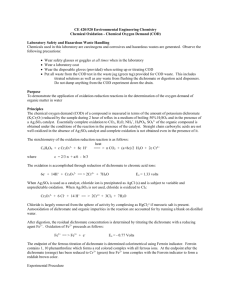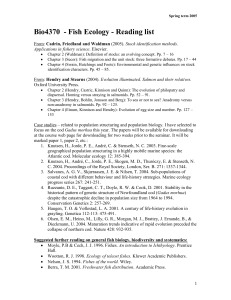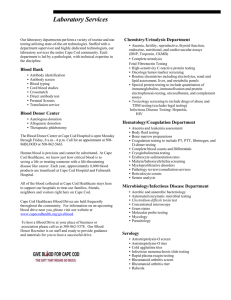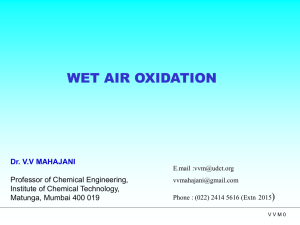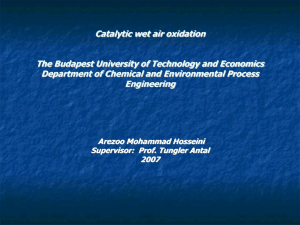to - Proposed Project Summary
advertisement
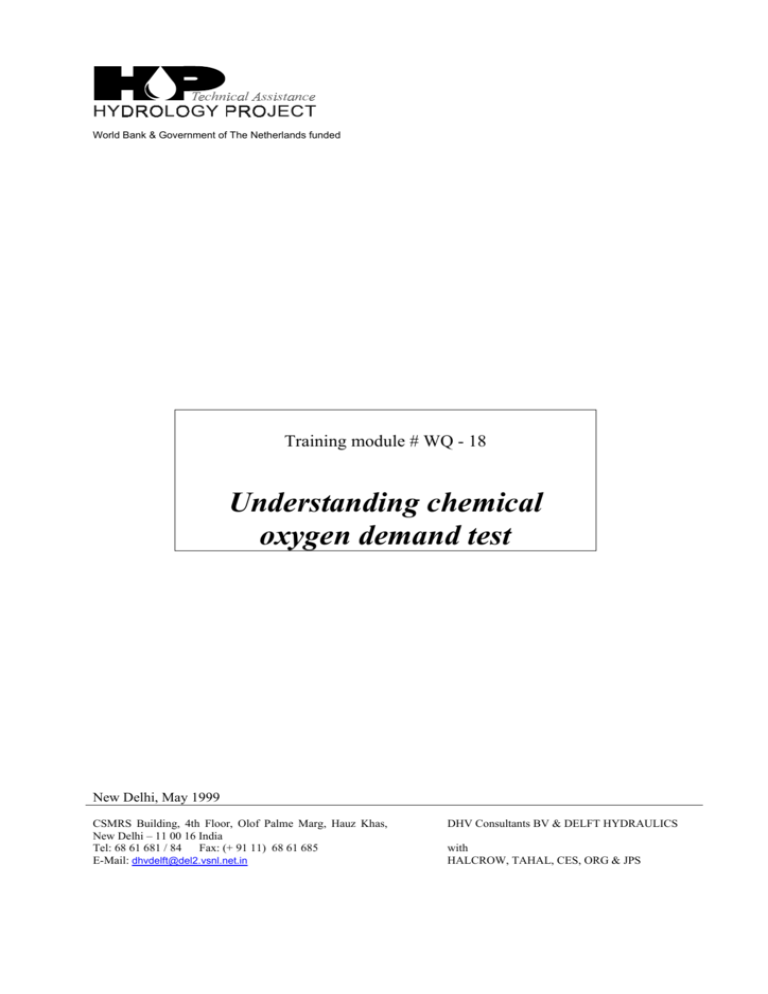
World Bank & Government of The Netherlands funded Training module # WQ - 18 Understanding chemical oxygen demand test New Delhi, May 1999 CSMRS Building, 4th Floor, Olof Palme Marg, Hauz Khas, New Delhi – 11 00 16 India Tel: 68 61 681 / 84 Fax: (+ 91 11) 68 61 685 E-Mail: dhvdelft@del2.vsnl.net.in DHV Consultants BV & DELFT HYDRAULICS with HALCROW, TAHAL, CES, ORG & JPS Table of contents Page Hydrology Project Training Module 1 Module context 2 2 Module profile 3 3 Session plan 4 4 Overhead/flipchart master 5 5 Evaluation sheets 22 6 Handout 24 7 Additional handout 29 8 Main text 32 File: “ 18 Understanding COD test.doc” Version 05/11/02 Page 1 1. Module context This module deals with significance and chemistry of chemical oxygen demand measurement. Modules in which prior training is required to complete this module successfully and other available, related modules in this category are listed in the table below. While designing a training course, the relationship between this module and the others, would be maintained by keeping them close together in the syllabus and place them in a logical sequence. The actual selection of the topics and the depth of training would, of course, depend on the training needs of the participants, i.e. their knowledge level and skills performance upon the start of the course. No. 1 Module title Basic water quality concepts Code WQ-01 • • 2 Basic chemistry conceptsa WQ-02 • • • 3 How to prepare solutionsa standard WQ-04 • • • 4 5 Understanding the chemistry WQ - 11 of dissolved oxygen measurementa • Understanding biochemical WQ - 15 oxygen demand testa • • Objectives Become familiar with the common water quality parameters Appreciate important water quality issues Convert units from one to another Understand the concepts of quantitative chemistry Report analytical results with correct number of significant digits Recognise different types of glassware Use an analytical balance and maintain it Prepare standard solutions Appreciate significance of DO measurement Understand the chemistry of DO measurement by Winkler method Understand the significance theory of BOD test and a – prerequisite Hydrology Project Training Module File: “ 18 Understanding COD test.doc” Version 05/11/02 Page 2 2. Module profile Title : Understanding chemical oxygen demand test Target group : HIS function(s): Q1, Q2, Q3, Q5 Duration : 1 session of 90 min Objectives : After the training the participants will be able to: Appreciate significance of COD measurement Understand the chemistry of COD measurement • • Key concepts : • • • • Training methods : Lecture, exercises and open discussions Training tools required : OHS Handouts : As provided in this module Further reading : and references • • Hydrology Project Training Module Significance Oxidation number Redox reactions Chemistry of COD test Analytical Chemistry: An introduction, D.A. Skoog and D. M. West/1986. Saunders College Publishing Chemistry for Environmental Engineering, C.N. Sawyer, P.L. McCarty and C.F. Parkin. McGraw-Hill, 1994 File: “ 18 Understanding COD test.doc” Version 05/11/02 Page 3 3. Session plan No 1 2 3 4 5 6 Activities Preparations Introduction Ask participants to name a few organic compounds • Explain the need for measuring aggregate organic • matter Describe the content of the lecture • Discuss the significance of the test • Oxidation-reduction reactions Explain oxidation and reduction in terms of electron • transfer Explain significance of oxidation number and how to • calculate it Explain balancing of redox reactions • Give exercise on balancing equations. Remove • difficulties COD test Describe the COD test • Explain calculations & formula • Interferences & precautions • Relation with other parameters Explain the relation of COD with BOD • Differentiate between COD and TOC • Explain the concept of ThCOD • Conclusion Recapitulate the significance of the test • Wrap up by enumerating the advantages and • limitations of the test Hydrology Project Training Module File: “ 18 Understanding COD test.doc” Time Tools 10 min OHS 30 min OHS 30 min Additional handout OHS 10 min OHS 10 min OHS Version 05/11/02 Page 4 4. Overhead/flipchart master OHS format guidelines Type of text Style Setting Headings: OHS-Title Arial 30-36, with bottom border line (not: underline) Text: OHS-lev1 OHS-lev2 Arial 24-26, maximum two levels Case: Italics: Listings: Sentence case. UPPERCASE. full text in OHS-lev1 OHS-lev1-Numbered Use occasionally and in a consistent way Big bullets. Numbers for definite series of steps. Avoid roman numbers and letters. OHS-Equation None, as these get lost in photocopying and some colours do not reproduce at all. Use of a table will ease horizontal alignment over more lines (columns) Use equation editor for advanced formatting only Colours: Formulas/Equat ions Avoid Hydrology Project Training Module File: “ 18 Understanding COD test.doc” Version 05/11/02 Page 5 Chemical Oxygen Demand • Significance • Chemistry of the test • Interferences • Relation to other parameters • Sample handling Hydrology Project Training Module File: “ 18 Understanding COD test.doc” Version 05/11/02 Page 6 Significance • Measures pollution potential of organic matter organic matter + oxidant ⇒ CO2 + H2O • Decomposable organic matter results in consumption of DO in the receiving streams • Does not differentiate between biologically degradable & nondegradable organic matter Hydrology Project Training Module File: “ 18 Understanding COD test.doc” Version 05/11/02 Page 7 Oxidation – reduction reactions • Comprise two half reactions − Removal of electrons - oxidation − Addition of electrons - reduction • Organic matter is oxidised to CO2 & H2O, electrons are released • Oxidising chemical is reduced while accepting the released electrons Hydrology Project Training Module File: “ 18 Understanding COD test.doc” Version 05/11/02 Page 8 Oxidation number • Gives oxidation state • Increases with oxidation or release of electrons • Decreases with reduction or acceptance of electrons • Some do not change in most reactions Ca 2+,Mg 2+, K 1+, H 1+, Na 1+, O 2- Hydrology Project Training Module File: “ 18 Understanding COD test.doc” Version 05/11/02 Page 9 Calculation of oxidation number • C6H12O6 H~ 12x1+ = 12+ O~ 6x2- = 12- − Therefore oxidation number of C must be 0, since the molecule has no net charge • Cr2O72- O~ 7x2- = 14- − Therefore oxidation number of Cr must be 6+, since the ion has a net charge of 2- and there are two atoms of Cr Hydrology Project Training Module File: “ 18 Understanding COD test.doc” Version 05/11/02 Page 10 Balancing reactions (1) • For oxidation of carbon in glucose by dichromate to carbon dioxide • Write the two half reactions separately along with the appropriate number of electrons to correspond with the change in oxidation number − C6H12O6 ⇒ 6CO2 +24e-, the oxidation number of C changes from 0 to 4+ − Cr2O72- + 6e- ⇒ 2Cr3+, the oxidation number of Cr changes from 6+ to 3+ Hydrology Project Training Module File: “ 18 Understanding COD test.doc” Version 05/11/02 Page 11 Balancing reactions (2) • Add either OH- or H+ to balance charge − C6H12O6 ⇒ 6CO2 +24e- + 24H+ − Cr2O72- + 6e- + 14 H+ ⇒ 2Cr3+ • Add water molecules to balance H an dO − C6H12O6 + 6H2O ⇒ 6CO2 +24e- + 24H+ − Cr2O72- + 6e- + 14 H+ ⇒ 2Cr3+ + 7H2O Hydrology Project Training Module File: “ 18 Understanding COD test.doc” Version 05/11/02 Page 12 Balancing reactions (3) • Multiply by an appropriate number to balance electrons in the two half reactions and add C6H12O6 + 6H2O ⇒ 6CO2 +24e- + 24H+ 4Cr2O72- + 24e- + 56 H+ ⇒ 2Cr3+ + 7H2O C6H12O6 + 4Cr2O72- + 32H+ ⇒ 6CO2 + 2Cr3+ + H2O Hydrology Project Training Module File: “ 18 Understanding COD test.doc” Version 05/11/02 Page 13 The COD test (1) • Sample is refluxed with known amount of excess dichromate in presence of acid • AgSO4 catalyst is used for oxidation of low molecular weight fatty acids • Remaining dichromate is titrated with FAS to determine that used for oxidising the organic matter 6Fe2+ + Cr2O72- = 6Fe3+ + 2Cr3+ 7H2O Hydrology Project Training Module File: “ 18 Understanding COD test.doc” Version 05/11/02 Page 14 The COD test (2) • Ferroin indicator gives a sharp change to brown colour on complete reduction of dichromate • FAS is a secondary standard, must be standardised frequently • Result expressed as mg/L COD Hydrology Project Training Module File: “ 18 Understanding COD test.doc” Version 05/11/02 Page 15 Example • Calculate COD, if 20 mL sample consumed 1.6 mL of 0.25 N potassium dichromate − potassium dichromate used = 1.6 mL x (0.25 meq/mL) = 0.4 meq − therefore COD of sample = (0.4 meq/ 20mL) x (1000mL/1 L) = 20 meq/ L − in terms of oxygen, COD = (20 meq/L) x (8 mg O2/meq) = 160 mg/ L Hydrology Project Training Module File: “ 18 Understanding COD test.doc” Version 05/11/02 Page 16 Calculation formula • To compensate for errors a distilled water blank is included COD, mg/L = (B-A)N x 8000/ sample volume, mL − B & A are volumes in mL of FAS used in titrating dichromate in the blank and sample after refluxing − N is the normality of FAS • Note that the normality of dichromate does not appear in the formula (why?) Hydrology Project Training Module File: “ 18 Understanding COD test.doc” Version 05/11/02 Page 17 Interferences & precautions • Chloride, present in samples is oxidised. Mercuric sulphate is used as a complexing agent. • Nitrite, ferrous iron, sulphide, exert COD. Their concentration in water samples, however, is low. • Amino nitrogen is released as ammonia. • Aromatic hydrocarbons and pyridines are not oxidised. • Samples for COD may be preserved by acidification to pH 2 or lower Hydrology Project Training Module File: “ 18 Understanding COD test.doc” Version 05/11/02 Page 18 Other parameters for organic matter • BOD value is always lower than COD value • For domestic and some industrial wastewater COD is about 2.5 times BOD • COD can be related to TOC also. TOC, however, does not account for oxidation state of organic matter • ThCOD of standard solutions can be calculated. It is used to standardise the procedure Hydrology Project Training Module File: “ 18 Understanding COD test.doc” Version 05/11/02 Page 19 Calculation of ThCOD • Calculate ThCOD of 890 mg/L glycine (CH3.NH2.CH.COOH) solution. − Write a balanced equation assuming that oxygen participates in the reaction CH3.NH2.CH.COOH + 3O2 = 3CO2 + NH3 + 2H2O − One mole glycine, MW 89g, has a demand of 16x6 = 96g O2 − Therefore ThCOD = 890 x 96/89 = 960 mg/L Hydrology Project Training Module File: “ 18 Understanding COD test.doc” Version 05/11/02 Page 20 In summary • The COD is a rapid & precise method for determination of aggregate organic matter • It does not differentiate between biodegradable and non-biodegradable organic matter • It can be related to the BOD value of the sample Hydrology Project Training Module File: “ 18 Understanding COD test.doc” Version 05/11/02 Page 21 5. Evaluation sheets Hydrology Project Training Module File: “ 18 Understanding COD test.doc” Version 05/11/02 Page 22 Hydrology Project Training Module File: “ 18 Understanding COD test.doc” Version 05/11/02 Page 23 6. Handout Hydrology Project Training Module File: “ 18 Understanding COD test.doc” Version 05/11/02 Page 24 Chemical Oxygen Demand • • • • • Significance Chemistry of the test Interferences Relation to other parameters Sample handling Significance • • • Measures pollution potential of organic matter organic matter + oxidant ⇒ CO2 + H2O Decomposable organic matter results in consumption of DO in the receiving streams Does not differentiate between biologically degradable & nondegradable organic matter Oxidation – reduction reactions • • • Comprise two half reactions − Removal of electrons - oxidation − Addition of electrons - reduction Organic matter is oxidised to CO2 & H2O, electrons are released Oxidising chemical is reduced while accepting the released electrons Oxidation number • • • • Gives oxidation state Increases with oxidation or release of electrons Decreases with reduction or acceptance of electrons Some do not change in most reactions Ca 2+,Mg 2+, K 1+, H 1+, Na 1+, O 2- Calculation of oxidation number H~ 12x1+ = 12+ O~ 6x2- = 12Therefore oxidation number of C must be 0, since the molecule has no net charge 2O~ 7x2- = 14Cr2O7 Therefore oxidation number of Cr must be 6+, since the ion has a net charge of 2- and there are two atoms of Cr C6H12O6 Balancing reactions (1) • • For oxidation of carbon in glucose by dichromate to carbon dioxide Write the two half reactions separately along with the appropriate number of electrons to correspond with the change in oxidation number C6H12O6 ⇒ 6CO2 +24e-, the oxidation number of C changes from 0 to 4+ Cr2O72- + 6e- ⇒ 2Cr3+, the oxidation number of Cr changes from 6+ to 3+ Hydrology Project Training Module File: “ 18 Understanding COD test.doc” Version 05/11/02 Page 25 Balancing reactions (2) • Add either OH- or H+ to balance charge C6H12O6 ⇒ 6CO2 +24e- + 24H+ Cr2O72- + 6e- + 14 H+ ⇒ 2Cr3+ • Add water molecules to balance H an dO C6H12O6 + 6H2O ⇒ 6CO2 +24e- + 24H+ Cr2O72- + 6e- + 14 H+ ⇒ 2Cr3+ + 7H2O Balancing reactions (3) Multiply by an appropriate number to balance electrons in the two half reactions and add C6H12O6 + 6H2O ⇒ 6CO2 +24e- + 24H+ • 4Cr2O72- + 24e- + 56 H+ ⇒ 2Cr3+ + 7H2O C6H12O6 + 4Cr2O72- + 32H+ ⇒ 6CO2 + 2Cr3+ + H2O The COD test (1) • • • Sample is refluxed with known amount of excess dichromate in presence of acid AgSO4 catalyst is used for oxidation of low molecular weight fatty acids Remaining dichromate is titrated with FAS to determine that used for oxidising the organic matter 6Fe2+ + Cr2O72- = 6Fe3+ + 2Cr3+ 7H2O The COD test (2) • • • Ferroin indicator gives a sharp change to brown colour on complete reduction of dichromate FAS is a secondary standard, must be standardised frequently Result expressed as mg/L COD Example • Calculate COD, if 20 mL sample consumed 1.6 mL of 0.25 N potassium dichromate potassium dichromate used = 1.6 mL x (0.25 meq/mL) = 0.4 meq therefore COD of sample = (0.4 meq/ 20mL) x (1000mL/1 L) = 20 meq/ L in terms of oxygen, COD = (20 meq/L) x (8 mg O2/meq) = 160 mg/ L Hydrology Project Training Module File: “ 18 Understanding COD test.doc” Version 05/11/02 Page 26 Calculation formula • • To compensate for errors a distilled water blank is included COD, mg/L = (B-A)N x 8000/ sample volume, mL B & A are volumes in mL of FAS used in titrating dichromate in the blank and sample after refluxing N is the normality of FAS Note that the normality of dichromate does not appear in the formula (why?) Interferences & precautions • • • • • Chloride, present in samples is oxidised. Mercuric sulphate is used as a complexing agent. Nitrite, ferrous iron, sulphide, exert COD. Their concentration in water samples, however, is low. Amino nitrogen is released as ammonia. Aromatic hydrocarbons and pyridines are not oxidised. Samples for COD may be preserved by acidification to pH 2 or lower Other parameters for organic matter • • • • BOD value is always lower than COD value For domestic and some industrial wastewater COD is about 2.5 times BOD COD can be related to TOC also. TOC, however, does not account for oxidation state of organic matter ThCOD of standard solutions can be calculated. It is used to standardise the procedure Calculation of ThCOD • Calculate ThCOD of 890 mg/L glycine (CH3.NH2.CH.COOH) solution. Write a balanced equation assuming that oxygen participates in the reaction CH3.NH2.CH.COOH + 3O2 = 3CO2 + NH3 + 2H2O One mole glycine, MW 89g, has a demand of 16x6 = 96g O2 Therefore ThCOD = 890 x 96/89 = 960 mg/L In summary • • • • The COD is a rapid & precise method for determination of aggregate organic matter It does not differentiate between biodegradable and non-biodegradable organic matter It can be related to the BOD value of the sample Hydrology Project Training Module File: “ 18 Understanding COD test.doc” Version 05/11/02 Page 27 Add copy of Main text in chapter 8, for all participants. Hydrology Project Training Module File: “ 18 Understanding COD test.doc” Version 05/11/02 Page 28 7. Additional handout 1. Calculate the oxidation number of Mn in Mn(OH)2, MnO4-, MnO2 2. Balance the half reactions: (i) Cl2 = Cl- (ii) Mn2+ = MnO2 Hydrology Project Training Module File: “ 18 Understanding COD test.doc” Version 05/11/02 Page 29 1. Calculate the oxidation number of Mn in Mn(OH)2, MnO4-, MnO2 Mn(OH)2 MnO4MnO2 2OH = 2-, therefore Mn = 2+ 4O = 8-, therefore Mn = 7+, since there is one negative charge on the ion 2O = 4-, therefore Mn = 4+ 2. Balance the half reactions: (i) Cl2 = ClThe change in oxidation number is 1, from 0 to –1. Add one chloride ion on R. H. S. to balance chlorine atoms. Add two electrons on L. H. S. for the two chlorine atoms since chlorine is getting reduced to chloride ion. No other adjustment is needed. Cl2 + 2e- = 2Cl- (ii) Mn2+ = MnO2 The change in oxidation number is 2, from 2+ to 4+. Add 2 electrons to R. H. S. since manganese dioxide has a higher oxidation number and is the oxidised form. Add 4H+ to R. H. S. to balance the charge. Finally add 2H2O to L. H. S. to balance H and O atoms. Mn2+ + 2H2O = MnO2 + 2e- + 4H+ Hydrology Project Training Module File: “ 18 Understanding COD test.doc” Version 05/11/02 Page 30 Hydrology Project Training Module File: “ 18 Understanding COD test.doc” Version 05/11/02 Page 31 8. Main text Contents Hydrology Project Training Module 1. Introduction 1 2. Chemistry of COD test 1 3. Interferences 3 4. Relationship of COD to Other Water Quality Parameters 4 5. Sample Handling and Storage 4 6. Problems 5 File: “ 18 Understanding COD test.doc” Version 05/11/02 Page 32 Understanding chemical oxygen demand test 1. Introduction The chemical oxygen demand (COD) analysis is designed to measure the maximum amount of oxygen that can be consumed by the organic matter in a sample of water. This is important because when organic polluting matter is discharged to the aquatic environment it will normally take up dissolved oxygen during its subsequent degradation thus reducing the amount of oxygen available for the respiration of fish and other aquatic life. The test is based upon the fact that all organic compounds, with a few exceptions, can be oxidised by the action of strong oxidising agents under acidic conditions. One of the limitations of the COD test is its inability to differentiate between biologically oxidisable and biologically inert organic matter. In addition it does not provide any evidence of the rate at which the biologically active material would be stabilised under conditions that exist in nature. As a result COD values are greater than BOD values and may be much greater when significant amounts of biologically resistant organic matter, such as lignin, is present. Nevertheless, the COD test, in comparison to the BOD test gives a rapid indication of the amount of oxygen a sample will demand when released to the aquatic environment. 2. Chemistry of COD test Potassium dichromate has been found to be the most suitable oxidant1. It is capable of oxidising a wide variety of organic substances almost completely to carbon dioxide and water. Certain organic compounds, particularly low molecular weight fatty acids are not oxidised unless silver sulphate catalyst is present. Aromatic hydrocarbons and pyridine are not oxidised under any circumstances. In the chemical reaction electrons are released by the organic molecule (glucose) being oxidised, such as C6H12O6 + 6H2O = 6CO2 + 24H+ + 24e- (1) The electrons are accepted by hexavalent chromium (Cr6+) which is reduced to trivalent chromium (Cr3+): Cr2O72- + 14H+ + 6e- = 2Cr3+ + 7H2O (2) The two half reactions can be added after multiplying Equation 1 by 4 for balancing of electrons to yield: 4Cr2O72- + 32H+ + C6H12O6 + = 8Cr3+ + 6CO2 + 22H2O (3) The following steps may be followed to balance redox (reduction-oxidation) reactions. Write the two half reactions separately showing the chemical species undergoing the change in oxidation state, for each case. Recognise the change in the oxidation numbers of species undergoing redox reactions. In Equation 1, the oxidation number of carbon atoms in glucose molecule is 0. It changes to +4 in carbon dioxide. In Equation 2, the oxidation number of chromium changes from +6 to +3. 1 Oxidation is defined as a loss of electrons, reduction as a gain of electrons. The term oxidation originates from a ‘reaction with oxygen’ (where the substance that was oxidised loses electrons to oxygen). Hydrology Project Training Module File: “ 18 Understanding COD test.doc” Version 05/11/02 Page 1 The oxidation numbers for chemical species may be determined in most cases by first assigning oxidation numbers1+ to H, 2- to O and 0 to whole molecules (other oxidation numbers which do not change and may be of use are: Ca & Mg 2+, K & Na 1+).Then summing the charges after taking into account the number of atoms in the specie and assigning an oxidation number to the element of interest to obtain the net charge on the specie. Thus for the carbon atom in glucose: H~(12x1+) + O~(6x2-)=0, therefore oxidation number for carbon is 0, since the molecule has no net charge. Similarly for the chromium atom in dichromate ion: O~(7x2-)=14-, therefore the oxidation number for chromium atom is 6+ since there are two atoms and the net charge on the specie is 2-. Add appropriate number of electrons to balance the change in the oxidation numbers in the two half reactions. Thus electrons were added to the right hand side of Equation 1, since carbon is oxidised releasing electrons and to the left hand side of Equation 2, since chromium is reduced while accepting electrons. Add appropriate number of either H+ or OH- ions to the left or right hand side of the two half reactions to balance the charges on the ionic species and the electrons. Add water molecules to balance H and O atoms in the two half equations. Multiply the half equations by suitable numbers to obtain the same number of electrons in each case. Add the two half equations. In the laboratory the COD test is carried out by digesting the sample with excess potassium dichromate and silver sulphate catalyst in strong sulphuric acid solution at an elevated temperature. In order to ensure that volatile compounds present in the sample and those formed during the digestion reaction do not escape, the digestion flask is fitted with a reflux condenser. Organic matter in the sample reduces part of the potassium dichromate and the remaining excess dichromate is titrated with ferrous ammonium sulphate (FAS). 6Fe2+ + Cr2O72- = 6Fe3+ + 2Cr3+ + 7H2O (4) FAS is a secondary standard and must be standardised against a primary standard such as potassium dichromate. Note that Equations 1 and 2 are half equations while Equations 3 and 4, are complete oxidation - reduction equations. All four equations are balanced in terms of charges and elements participating in the reaction. Example 1 Calculate the normality of 0.1M potassium dichromate solution used for oxidation of organic matter in COD test. From Equation 1 it is seen that hexavalent chromium in one mole of dichromate ion is reduced to trivalent chromium by accepting 6 electrons. Therefore each mole of dichromate has 6 equivalents and 0.1 M solution will be 0.6 N Hydrology Project Training Module File: “ 18 Understanding COD test.doc” Version 05/11/02 Page 2 The oxidiseable organic matter in the sample is reported in terms of oxygen equivalent. Example 2 Calculate COD of a sample of water if 20 mL of the sample consumed 1.6 mL of 0.25 N potassium dichromate solution. Potassium dichromate consumed = 1.6 mL X 0.25 meq/mL = 0.4 meq Therefore COD of the sample = 0.4 meq/ 20 mL X 1000 mL/ L = 20 meq/L In terms of oxygen, COD = 20 meq/L X 8 mg O2/meq = 160 mg/L. It is important that organic matter from outside sources is not included in the COD value. Therefore, a distilled water blank is run along with the sample and an adjustment is made in calculations accordingly. A very marked change in oxidation - reduction potential occurs at the end point of the titration with ferrous ammonium sulphate. Ferroin, 1,10 phenanthroline sulphate, is used as an indicator. It gives a very sharp change to brown colour on complete reduction of the dichromate by ferrous ammonium sulphate. Example 3 Derive a formula for calculating COD value from the following information: N1 = normality of ferrous ammonium sulphate (FAS) N2 = potassium dichromate, V = mL volume of potassium dichromate taken for reaction for sample and blank, A = mL volume of FAS used in titration for sample after digestion, B = mL volume of FAS used in titration for blank after digestion, S = mL volume of sample and blank meq of oxidant taken = N2.V, meq of oxidant remaining in the sample and blank flasks after digestion = N1.A and N1.B, respectively. Therefore meq of oxidant consumed in the sample and blank flasks = (N2.V - N1.A) and (N2.V - N1.B), respectively, and meq of oxidant consumed by the organic matter in the sample = (N2.V - N1.A) - (N2.V - N1.B) = (B -A).N1. Hence COD of sample = (B - A).N1 X 1000/S, meq/L = (B - A).N1 X 8000/S, mg O2/L 3. Interferences Certain reduced inorganic compounds can be oxidised under the conditions of the test and thus can cause erroneously high results. Chlorides cause the most serious problem because of their normally high concentration in water and wastewater samples. This interference can be eliminated by the addition of mercuric sulphate to the sample, prior to addition of other chemicals. The mercuric ion combines with the chloride ion to form a poorly ionised mercuric chloride complex. Hydrology Project Training Module File: “ 18 Understanding COD test.doc” Version 05/11/02 Page 3 The amino nitrogen in organic compounds is converted to ammonia. Nitrite, however, is oxidised to nitrates. But nitrite seldom occurs in significant amounts in natural water. This also holds true for other possible interference such as ferrous iron and sulphides. 4. Relationship of COD to Other Water Quality Parameters As mentioned earlier the COD value of a sample is always higher than its BOD value. This is due to the fact that the COD test measures both the biologically degradable and biologically non-degradable organic matter. Further, COD test measures the total oxygen equivalents of the organic matter while the BOD test measures oxygen equivalents of organic matter which is degraded in 3 days. This 3 day value is about 70 % of the ultimate BOD. However COD data can be interpreted in terms of BOD values after sufficient experience has been accumulated to establish reliable correlation factors. For domestic wastewaters and many decomposable industrial wastes, COD is about 2.5 times the BOD. For unpolluted surface and ground waters this ratio is higher. COD value can be related to total organic carbon (TOC) value also which is a measure of organic carbon atoms in a sample. However it should be noted that two compounds might have the same TOC value but different COD values. This is because the COD value depends on the oxidation state of the carbon atoms in the compound. Where formula of the organic compounds present in the waste is known, the COD value can be related to the theoretical chemical oxygen demand (ThCOD) which is the oxygen required to completely oxidise the organic matter to carbon dioxide and water. Example 4 Calculate the theoretical chemical oxygen demand of a sample of wastewater from an industry containing 890 mg/L of glycine, CH3.NH2.CH.COOH. Write a balanced equation for oxidation, taking amino nitrogen to be converted to ammonia and carbon atoms to carbon dioxide. Balance hydrogen atoms by adding required number of water molecules to the right side of the equation. Count number of oxygen atoms needed for balancing and add them to the left side as oxygen demand. C3H7O2N + 3O2 = 3CO2 + NH3 + 2H2O Therefore one mole of glycine ( 89 g ) has a theoretical chemical oxygen demand of 3 moles of oxygen ( 96 g ) or the waste will have a demand of (96/ 89) X 890 = 960 mg/L. Standard solutions of pure organic compounds are often used to evaluate the accuracy of laboratory measurements. 5. Sample Handling and Storage After a sample of water containing organic matter has been collected there is the possibility that natural biochemical reactions within the sample will act to reduce the COD. Samples should therefore be tested without delay. If delay in analysing the sample is unavoidable the sample should be preserved by acidification to pH = 2 or below. Hydrology Project Training Module File: “ 18 Understanding COD test.doc” Version 05/11/02 Page 4 6. Problems 1. Why do BOD and COD values for the same water sample are always different? Give two reasons. 2. What general groups of organic compounds are not oxidised in the COD test ? 3. Write a balanced oxidation reduction equation for oxidation of chloride ion by potassium dichromate in absence of mercuric sulphate. 4. What is the normality of 0.1 molar ferrous ammonium sulphate when used for titrating potassium dichromate ? 5. Estimate the COD of a 500 mg/L solution of glucose. What will be its BOD-3 value if it is assumed that it is readily biodegradable? 6. Calculate and compare the theoretical oxygen demand and TOC values of 0.2 M solutions of acetic acid, CH3COOH, and ethyl alcohol, CH3CH2OH. Hydrology Project Training Module File: “ 18 Understanding COD test.doc” Version 05/11/02 Page 5
